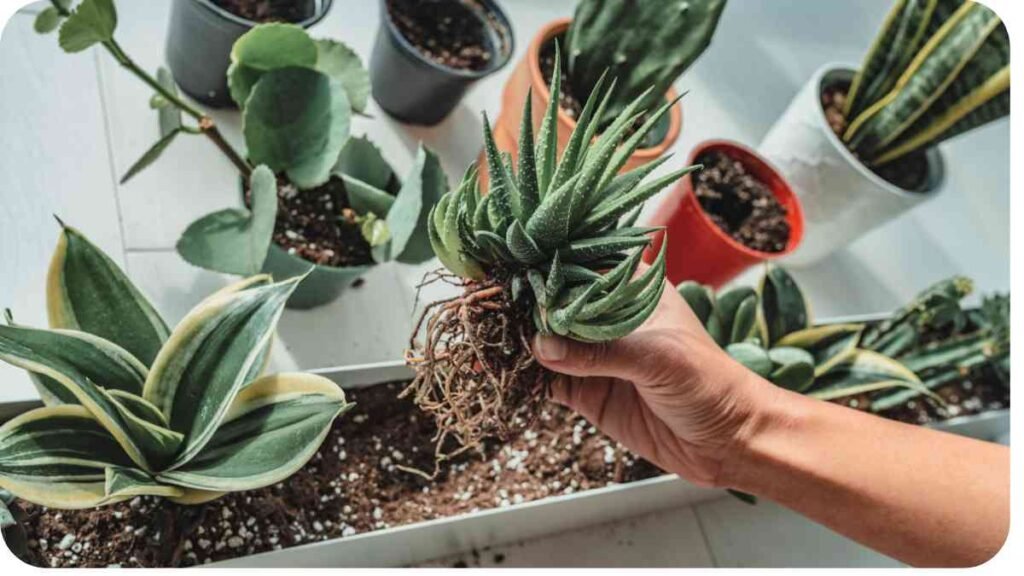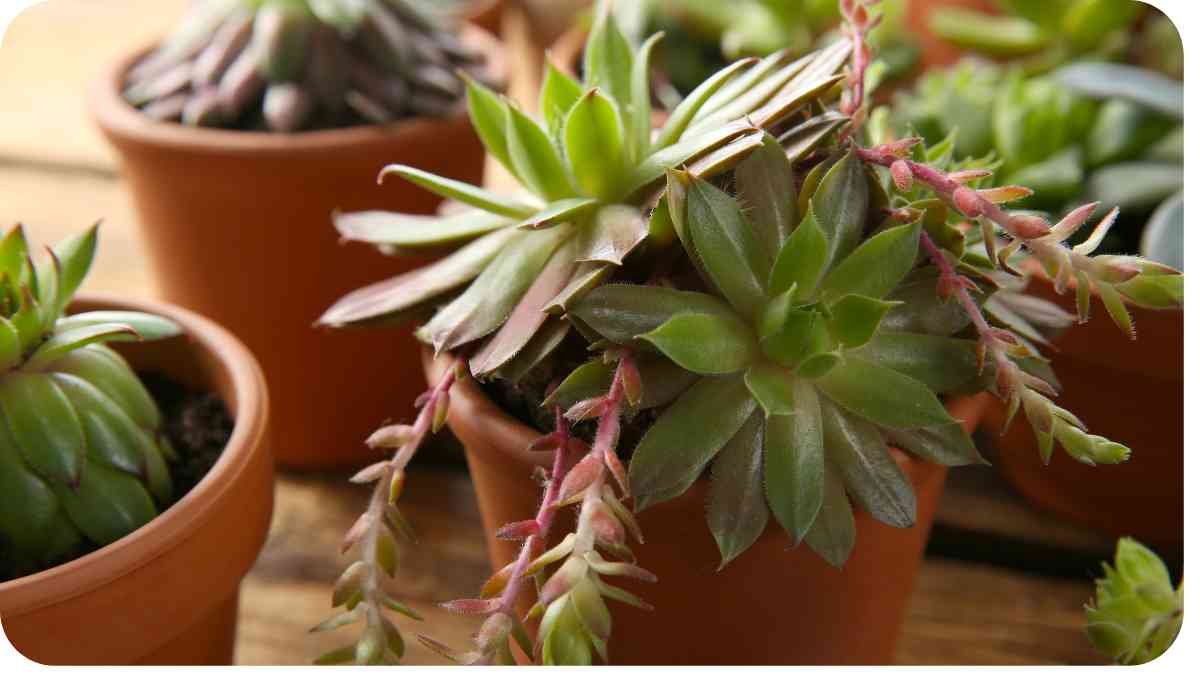Echeverias are among the most popular and beloved succulents, known for their stunning rosette-shaped leaves and vibrant colors. Originating from semi-desert regions in Central America, these plants have adapted to thrive in dry, arid conditions.
With proper care, they can bring beauty and charm to any indoor or outdoor space.
| Takeaways |
|---|
| 1. Understanding the needs of your Echeveria is crucial for their health and vitality. |
| 2. Choose the right variety based on your environment and care capabilities. |
| 3. Provide ample sunlight while avoiding direct exposure to prevent sunburn. |
| 4. Water sparingly and allow the soil to dry out completely between waterings to prevent root rot. |
| 5. Use a well-draining potting mix and provide adequate drainage to promote healthy root development. |
| 6. Adjust your care routine seasonally to accommodate changes in temperature and daylight hours. |
| 7. Regularly inspect your Echeveria for signs of pests and diseases and take prompt action to prevent infestations. |
| 8. Get creative with display options to showcase the beauty of your Echeveria indoors and outdoors. |
| 9. Address common issues such as overwatering, underwatering, and leggy growth promptly to maintain plant health. |
| 10. Share your knowledge and experiences with other succulent enthusiasts to foster a sense of community and learning. |
Choosing the Right Echeveria Varieties

When it comes to selecting Echeveria varieties for your collection, the options are endless. From classic species like Echeveria elegans to more exotic hybrids, each variety has its own unique characteristics and care requirements. Here’s a table summarizing some common Echeveria varieties and their care needs:
Mastering the care of succulents requires attention to detail and understanding their unique needs. With proper techniques and strategies, your Echeveria can thrive in any environment. Learn more about succulent care to keep your plants healthy and vibrant.
| Echeveria Variety | Description | Care Needs |
|---|---|---|
| Echeveria ‘Lola’ | Rosettes of blue-gray leaves with pink tips | Bright, indirect sunlight; well-draining soil |
| Echeveria ‘Perle von Nurnberg’ | Purple and gray leaves with pink highlights | Moderate sunlight; infrequent watering |
| Echeveria ‘Topsy Turvy’ | Curly, twisted leaves with silvery-blue hue | Bright, indirect light; minimal water |
Each variety may have specific preferences for sunlight, water, and soil conditions, so it’s essential to research the needs of your chosen plants.
Sunlight Requirements: Finding the Sweet Spot
Proper sunlight is crucial for the health and vitality of your Echeveria. These plants thrive in bright, indirect light, mimicking their natural habitat. Placing them near a south or west-facing window where they can receive several hours of sunlight each day is ideal.
However, be cautious of exposing them to direct sunlight for extended periods, as it can lead to sunburn and leaf damage. If you notice your Echeveria stretching or becoming leggy, it may be a sign that it’s not receiving enough light.
Watering Your Echeveria: Dos and Don’ts
Watering is perhaps the most critical aspect of Echeveria care. As succulents, they are adapted to survive in dry conditions and are highly susceptible to root rot if overwatered.
The key is to allow the soil to dry out completely between waterings. Here’s a helpful guide for watering frequency based on different Echeveria species:
If your rattlesnake plant is drooping, it may be signaling distress. Understanding the reasons behind its condition is crucial for effective revival. Explore this comprehensive guide on rattlesnake plant care to restore your plant to its former glory.
| Echeveria Species | Watering Frequency |
|---|---|
| Echeveria agavoides | Every 7-10 days |
| Echeveria gibbiflora | Every 10-14 days |
| Echeveria pulidonis | Every 14-21 days |
Remember, it’s better to underwater than overwater your Echeveria. During the winter months or periods of dormancy, reduce watering frequency to prevent moisture-related issues.
Soil and Potting: Creating the Perfect Environment

The right soil mixture is essential for the health and growth of your Echeveria. These plants thrive in well-draining soil that prevents water from pooling around the roots.
A common mistake many succulent enthusiasts make is using standard potting soil, which can retain too much moisture and lead to root rot. Instead, opt for a specialized succulent or cactus mix, or create your own by combining equal parts of potting soil, perlite, and coarse sand.
Here’s a breakdown of the ideal soil mix for Echeveria:
| Ingredient | Purpose |
|---|---|
| Potting Soil | Provides nutrients and stability |
| Perlite | Improves drainage and aeration |
| Coarse Sand | Enhances drainage and prevents compaction |
When repotting your Echeveria, choose a container with drainage holes to allow excess water to escape freely. Avoid using pots that are too large, as this can lead to waterlogged soil and root rot. Instead, opt for a slightly snug fit to encourage healthy root growth.
Temperature and Humidity Considerations
Echeverias are naturally adapted to warm, dry climates and thrive in temperatures between 65°F and 80°F (18°C to 27°C). However, they can tolerate slightly cooler temperatures, especially during the winter months, as long as they are kept dry to prevent frost damage. Avoid exposing your Echeveria to extreme temperature fluctuations, as this can stress the plant and make it more susceptible to pests and diseases.
In terms of humidity, Echeverias prefer low to moderate humidity levels. High humidity can promote fungal growth and lead to issues like rot and mold. To increase air circulation and reduce humidity around your plants, avoid overcrowding them and provide adequate spacing between pots.
Pruning and Propagation Techniques
Pruning is an essential aspect of Echeveria care, helping to maintain the plant’s shape and remove any dead or damaged leaves. When pruning your Echeveria, use clean, sharp scissors or pruning shears to make precise cuts. Be sure to remove any leaves that show signs of rot or disease to prevent the spread to healthy parts of the plant.
Propagation is another exciting aspect of Echeveria care, allowing you to expand your collection and share your love for these beautiful succulents with others. There are several methods of propagation, including leaf cuttings, stem cuttings, and offsets (also known as pups). Here’s a table outlining the different propagation methods for Echeveria:
Are you puzzled by your ice plant’s lack of blooms? Discover the secrets behind encouraging abundant flowering in your ice plant. Uncover the mysteries with insights into ice plant blooming for a more vibrant garden.
| Propagation Method | Description |
|---|---|
| Leaf Cuttings | Remove healthy leaves and allow them to callus before planting in well-draining soil |
| Stem Cuttings | Cut a healthy stem and allow it to callus before planting in soil or water |
| Offsets (Pups) | Separate small offsets that grow at the base of the plant and replant them in their own pots |
Propagation can be a rewarding and enjoyable experience, allowing you to witness the growth and development of new plants from a single parent.
Dealing with Common Pests and Diseases
Despite their resilience, Echeverias are not immune to pests and diseases. Some common issues you may encounter include mealybugs, aphids, and fungal infections. Here’s a brief overview of how to identify and address these problems:
Mealybugs
These small, white insects feed on the sap of succulent plants, causing wilting and yellowing of leaves. To control mealybug infestations, gently wipe affected areas with a cotton swab dipped in rubbing alcohol. In severe cases, you may need to use insecticidal soap or neem oil to eliminate them.
Aphids
Aphids are tiny, pear-shaped insects that cluster on new growth, sucking the sap from the plant and causing distortion and discoloration of leaves. To get rid of aphids, spray your Echeveria with a strong jet of water to dislodge them. You can also use insecticidal soap or neem oil to control infestations.
Fungal Infections
Excessive moisture can lead to fungal diseases such as root rot and powdery mildew in Echeverias. To prevent fungal infections, avoid overwatering and ensure proper air circulation around your plants. If you notice signs of fungal growth, remove affected leaves and treat the plant with a fungicide.
Regularly inspecting your Echeveria for signs of pests and diseases and taking prompt action can help prevent serious damage and keep your plants healthy.
Seasonal Care: Adjusting to the Changing Needs
Echeverias have distinct seasonal requirements, and adjusting your care routine accordingly can help them thrive throughout the year.
Spring and Summer
During the active growing season, provide ample sunlight and water your Echeverias regularly, allowing the soil to dry out between waterings. Monitor for signs of new growth and adjust watering frequency as needed.
Fall and Winter
As temperatures drop and daylight hours decrease, Echeverias enter a period of dormancy. Reduce watering frequency to prevent waterlogged soil and protect your plants from frost by bringing them indoors or providing frost protection.
By understanding and accommodating the seasonal needs of your Echeveria, you can promote healthy growth and ensure their long-term success.
In the next section, we’ll explore creative ideas for displaying your Echeveria and adding beauty to your home or garden.
Reviving a lawn after a tough season is essential for restoring its lushness and vibrancy. With the right approach, you can transform your lawn into a vibrant green oasis once again. Explore effective strategies for reviving your lawn to enjoy a beautiful outdoor space.
Displaying Your Echeveria
Echeverias not only thrive in various environments but also add a touch of elegance and charm to any space. Here are some creative ideas for displaying your Echeveria and showcasing their beauty:
1. Succulent Arrangements
Create stunning succulent arrangements by combining Echeverias with other drought-tolerant plants like sedums, aeoniums, and haworthias. Choose containers of varying shapes, sizes, and materials to add visual interest and complement your decor.
2. Terrarium Gardens
Build miniature terrarium gardens using glass containers or open-air terrariums to showcase your Echeverias. Layer the bottom with drainage material like gravel or activated charcoal, followed by a well-draining succulent soil mix. Arrange your plants creatively, adding decorative stones or figurines for added flair.
3. Hanging Displays
Hang Echeverias in macramé plant hangers or decorative baskets to create vertical gardens indoors or on your patio. Choose trailing varieties like Echeveria ‘Lola’ or ‘Perle von Nurnberg’ for a cascading effect, adding a whimsical touch to any space.
4. Living Wreaths
Craft living wreaths using a wire or moss frame, planting Echeveria rosettes along with other succulents and mosses. Hang them on your front door or use them as centerpieces for special occasions to add a natural, rustic touch to your decor.
5. Indoor Gardens
Design indoor succulent gardens using shallow containers or trays, arranging Echeverias alongside other succulent varieties and decorative accents like driftwood or polished stones. Place them on windowsills, shelves, or coffee tables to create eye-catching displays that brighten up any room.
Elevate your patio with stunning container gardening ideas. Transform your outdoor space into a lush paradise with creative and beautiful plant arrangements. Discover the art of container gardening to enhance the ambiance and aesthetic appeal of your patio.
6. Outdoor Landscapes
Incorporate Echeverias into your outdoor landscape design by planting them in rock gardens, drought-tolerant beds, or along pathways. Combine them with other desert plants like agaves, yuccas, and cacti to create a low-maintenance, water-wise garden that thrives in hot, dry climates.
With a little creativity and imagination, you can transform your Echeverias into stunning focal points that enhance your home or garden decor.
In the next section, we’ll discuss common issues and troubleshooting tips to help you address problems and keep your Echeveria thriving.
Troubleshooting: Addressing Problems Early
Even with the best care, Echeverias may encounter challenges that can affect their health and appearance. Here are some common issues and troubleshooting tips to help you address them promptly:
1. Overwatering
Symptoms: Yellowing or mushy leaves, root rot, wilting.
Solution: Allow the soil to dry out completely between waterings and adjust your watering frequency accordingly. Ensure proper drainage in your pots and avoid leaving water sitting in saucers.
2. Underwatering
Symptoms: Wrinkled or shriveled leaves, leaf drop, wilting.
Solution: Increase watering frequency, especially during the active growing season. Monitor your Echeveria’s moisture needs and adjust as necessary based on environmental conditions.
3. Sunburn
Symptoms: Brown or white patches on leaves, leaf curling or shriveling.
Solution: Gradually acclimate your Echeveria to direct sunlight to prevent sunburn. Provide shade during the hottest part of the day, especially in summer months.
4. Pest Infestations
Symptoms: Visible insects, sticky residue on leaves, distorted growth.
Solution: Remove pests manually with a gentle stream of water or by using insecticidal soap or neem oil. Quarantine affected plants to prevent the spread of pests to other plants.
5. Fungal Diseases
Symptoms: White or gray powdery patches on leaves, yellowing or wilting.
Solution: Improve air circulation around your plants and avoid overhead watering to reduce humidity levels. Treat affected plants with a fungicide according to the manufacturer’s instructions.
6. Leggy Growth
Symptoms: Elongated stems, sparse foliage, stretching towards light.
Solution: Provide adequate sunlight and rotate your Echeveria regularly to promote even growth. Prune leggy stems to encourage bushier growth and remove any dead or damaged leaves.
7. Seasonal Dormancy
Symptoms: Reduced growth, leaf drop, changes in coloration.
Solution: Adjust your care routine to accommodate seasonal changes, including reducing watering frequency and providing protection from extreme temperatures.
By recognizing and addressing problems early, you can help your Echeveria recover and thrive. Regular monitoring and proactive care are key to maintaining healthy and beautiful plants.
Conclusion
Congratulations on mastering the art of succulent care and learning valuable tips for keeping your Echeveria thriving! By understanding the unique needs of these beautiful plants and providing proper care, you can enjoy their beauty and charm for years to come.
Throughout this journey, we’ve explored various aspects of Echeveria care, from choosing the right varieties to troubleshooting common problems. We’ve discussed the importance of sunlight, watering, soil, and seasonal adjustments, as well as creative ideas for displaying your Echeveria and adding beauty to your home or garden.
Remember, growing succulents like Echeverias is a rewarding experience that requires patience, observation, and a bit of trial and error. Don’t be discouraged by setbacks or challenges along the way each obstacle presents an opportunity to learn and grow as a succulent enthusiast.
Further Reading
- The Spruce – How to Grow Echeveria: Explore expert tips and techniques for cultivating healthy Echeverias, including sunlight, watering, and soil requirements.
- Be Green – Mastering Indoor Succulent Care: Learn insider secrets from succulent experts on how to care for indoor Echeverias and create an optimal environment for thriving plants.
- MasterClass – Echeveria Succulent Guide: Delve into the fascinating world of Echeverias with this comprehensive guide, covering everything from species identification to propagation techniques.
FAQs
How much sunlight do Echeverias need?
Echeverias thrive in bright, indirect light. Place them near a south or west-facing window where they can receive several hours of sunlight each day.
How often should I water my Echeveria?
Water your Echeveria sparingly, allowing the soil to dry out completely between waterings. In general, water them every 7-10 days during the active growing season and reduce frequency during the winter months.
What type of soil is best for Echeverias?
Echeverias require well-draining soil to prevent root rot. Use a specialized succulent or cactus potting mix, or create your own blend using equal parts potting soil, perlite, and coarse sand.
How do I propagate Echeverias?
Echeverias can be propagated through leaf cuttings, stem cuttings, offsets (pups), or division. Each method has its own requirements and success rates, so experiment to find what works best for you.
What should I do if my Echeveria is leggy?
If your Echeveria becomes leggy, it may not be receiving enough sunlight. Move it to a brighter location and prune leggy stems to encourage bushier growth.

Hellen James, a seasoned author at Unified Publishers LLC, brings a wealth of expertise to diverse niches. Specializing in pet care, outdoor adventures, lifestyle, wellness, and culinary delights, Hellen crafts insightful and engaging content that unlocks the full potential of readers’ interests. Explore, learn, and thrive with Hellen James.

